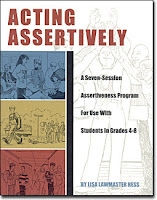Third and final post on assertiveness, imported from my counselor Moodle.
One of
the best ways we can build our children's assertiveness is by teaching them how
to send the messages they want to send. To help them do this, we can teach them
to ask themselves four questions:
Have I chosen my words carefully? Words are the building blocks of our messages, and well-chosen words that show respect for another person are the foundation of a strong message. Name-calling, sarcasm and put-downs may appear to be a show of strength, but in reality, bullying behaviors like these weaken our messages because they diminish other people's respect for us.
Does my tone of voice match the message I want to convey? The most thoughtfully considered words can deliver a completely different message if the tone in which they are spoken is pushy, disrespectful or harsh. Kids often have trouble recognizing their tone, however, and may even need you to model the appropriate tone for them...gently and without sarcasm.
Does my body language match the message I want to send? Stance, or body position, can strengthen or weaken a message. Someone who stands stoop-shouldered and stares at the floor will not come across as confident and is unlikely to be taken seriously. In addition, an open, friendly expression (think smiling mouth and eyes) inspires cooperation more readily than an angry or hostile one, and gestures or stances that can be interpreted as aggressive, such as clenched fists or hands on hips can make even a peaceful message look like a declaration of war.
Am I making eye contact? Eye contact is the part of nonverbal communication that shows you mean business. When we're nervous or afraid, however, it can be very difficult to maintain eye contact. Consequently, we undermine our whole message because the other person doesn't take us seriously. It takes practice, however, to keep our eyes focused on another person's eyes, however, especially when we are nervous or upset.
It's a lot to remember! Chances are, however, that your child has most of this down already, and may simply need some fine-tuning. Role-playing with you or practicing in front of a mirror can help him to refine all of the components of his message.
Once your kids start feeling confident with the whole picture, it's important to discuss where and when it's most appropriate to use these new-found skills. In general, assertive messages are best used with peers and adults with whom the child already has a good relationship built on trust and mutual respect. Assertive behavior is often not appreciated by authoritarian adults, and can even be dangerous when used with bullies.
Even adults with well-developed assertiveness skills may find it difficult - or even inappropriate - to be assertive all the time. If we look at assertive messages and behaviors as a set of skills that can be learned and used as needed, and if we teach our children those skills in the context of mutual respect, we are arming them with a life skill that they can use long after playground politics have become history. And, in the process, we may give ourselves permission to use those same skills.
Have I chosen my words carefully? Words are the building blocks of our messages, and well-chosen words that show respect for another person are the foundation of a strong message. Name-calling, sarcasm and put-downs may appear to be a show of strength, but in reality, bullying behaviors like these weaken our messages because they diminish other people's respect for us.
Does my tone of voice match the message I want to convey? The most thoughtfully considered words can deliver a completely different message if the tone in which they are spoken is pushy, disrespectful or harsh. Kids often have trouble recognizing their tone, however, and may even need you to model the appropriate tone for them...gently and without sarcasm.
Does my body language match the message I want to send? Stance, or body position, can strengthen or weaken a message. Someone who stands stoop-shouldered and stares at the floor will not come across as confident and is unlikely to be taken seriously. In addition, an open, friendly expression (think smiling mouth and eyes) inspires cooperation more readily than an angry or hostile one, and gestures or stances that can be interpreted as aggressive, such as clenched fists or hands on hips can make even a peaceful message look like a declaration of war.
Am I making eye contact? Eye contact is the part of nonverbal communication that shows you mean business. When we're nervous or afraid, however, it can be very difficult to maintain eye contact. Consequently, we undermine our whole message because the other person doesn't take us seriously. It takes practice, however, to keep our eyes focused on another person's eyes, however, especially when we are nervous or upset.
It's a lot to remember! Chances are, however, that your child has most of this down already, and may simply need some fine-tuning. Role-playing with you or practicing in front of a mirror can help him to refine all of the components of his message.
Once your kids start feeling confident with the whole picture, it's important to discuss where and when it's most appropriate to use these new-found skills. In general, assertive messages are best used with peers and adults with whom the child already has a good relationship built on trust and mutual respect. Assertive behavior is often not appreciated by authoritarian adults, and can even be dangerous when used with bullies.
Even adults with well-developed assertiveness skills may find it difficult - or even inappropriate - to be assertive all the time. If we look at assertive messages and behaviors as a set of skills that can be learned and used as needed, and if we teach our children those skills in the context of mutual respect, we are arming them with a life skill that they can use long after playground politics have become history. And, in the process, we may give ourselves permission to use those same skills.


No comments:
Post a Comment